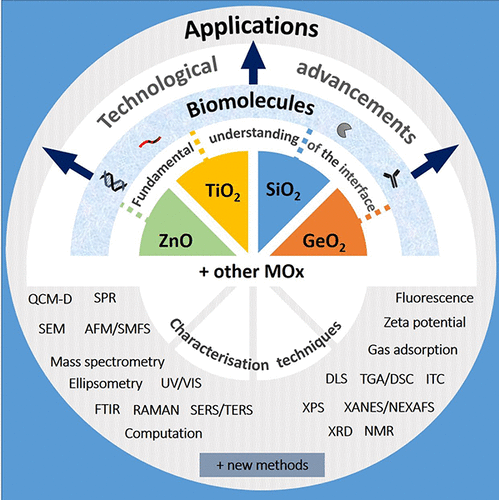当前位置:
X-MOL 学术
›
Chem. Rev.
›
论文详情
Our official English website, www.x-mol.net, welcomes your
feedback! (Note: you will need to create a separate account there.)
Interactions between Metal Oxides and Biomolecules: from Fundamental Understanding to Applications
Chemical Reviews ( IF 51.4 ) Pub Date : 2018-10-26 00:00:00 , DOI: 10.1021/acs.chemrev.7b00660 Marion J. Limo 1, 2 , Anna Sola-Rabada 1 , Estefania Boix 1, 3 , Veeranjaneyulu Thota 1 , Zayd C. Westcott 1 , Valeria Puddu 1 , Carole C. Perry 1
Chemical Reviews ( IF 51.4 ) Pub Date : 2018-10-26 00:00:00 , DOI: 10.1021/acs.chemrev.7b00660 Marion J. Limo 1, 2 , Anna Sola-Rabada 1 , Estefania Boix 1, 3 , Veeranjaneyulu Thota 1 , Zayd C. Westcott 1 , Valeria Puddu 1 , Carole C. Perry 1
Affiliation

|
Metallo-oxide (MO)-based bioinorganic nanocomposites promise unique structures, physicochemical properties, and novel biochemical functionalities, and within the past decade, investment in research on materials such as ZnO, TiO2, SiO2, and GeO2 has significantly increased. Besides traditional approaches, the synthesis, shaping, structural patterning, and postprocessing chemical functionalization of the materials surface is inspired by strategies which mimic processes in nature. Would such materials deliver new technologies? Answering this question requires the merging of historical knowledge and current research from different fields of science. Practically, we need an effective defragmentation of the research area. From our perspective, the superficial accounting of material properties, chemistry of the surfaces, and the behavior of biomolecules next to such surfaces is a problem. This is particularly of concern when we wish to bridge between technologies in vitro and biotechnologies in vivo. Further, besides the potential practical technological efficiency and advantages such materials might exhibit, we have to consider the wider long-term implications of material stability and toxicity. In this contribution, we present a critical review of recent advances in the chemistry and engineering of MO-based biocomposites, highlighting the role of interactions at the interface and the techniques by which these can be studied. At the end of the article, we outline the challenges which hamper progress in research and extrapolate to developing and promising directions including additive manufacturing and synthetic biology that could benefit from molecular level understanding of interactions occurring between inanimate (abiotic) and living (biotic) materials.
中文翻译:

金属氧化物和生物分子之间的相互作用:从基础的理解到应用
基于金属氧化物(MO)的生物无机纳米复合材料具有独特的结构,物理化学特性和新颖的生物化学功能,并且在过去的十年中,对诸如ZnO,TiO 2,SiO 2和GeO 2等材料的研究进行了投资已经大大增加了。除了传统方法外,材料表面的合成,成型,结构图案化和后处理化学功能化还受到模仿自然过程的策略的启发。这样的材料会带来新技术吗?回答这个问题需要融合历史知识和来自不同科学领域的最新研究。实际上,我们需要对研究区域进行有效的碎片整理。从我们的角度来看,对材料特性,表面化学以及表面附近生物分子的行为进行表面核算是一个问题。当我们希望在体外技术和体内生物技术之间架起桥梁时,这一点尤其值得关注。进一步,除了此类材料可能具有的潜在实用技术效率和优势外,我们还必须考虑材料稳定性和毒性的更广泛的长期影响。在这项贡献中,我们对基于MO的生物复合材料的化学和工程学的最新进展进行了批判性的综述,着重介绍了相互作用在界面上的作用以及可以研究这些相互作用的技术。在文章的最后,我们概述了阻碍研究进展的挑战,并将其推论到发展和有前途的方向,包括增材制造和合成生物学,这些可能会受益于无生命(非生物)材料与生物(生物)材料之间相互作用的分子水平理解。 。我们必须考虑材料稳定性和毒性的更广泛的长期影响。在这项贡献中,我们对基于MO的生物复合材料的化学和工程学的最新进展进行了批判性的综述,着重介绍了相互作用在界面上的作用以及可以研究这些相互作用的技术。在文章的最后,我们概述了阻碍研究进展的挑战,并将其推论到发展和有前途的方向,包括增材制造和合成生物学,这些可能会受益于无生命(非生物)材料与生物(生物)材料之间相互作用的分子水平理解。 。我们必须考虑材料稳定性和毒性的更广泛的长期影响。在这项贡献中,我们对基于MO的生物复合材料的化学和工程学的最新进展进行了批判性的综述,着重介绍了相互作用在界面上的作用以及可以研究这些相互作用的技术。在文章的最后,我们概述了阻碍研究进展的挑战,并将其推论到发展和有前途的方向,包括增材制造和合成生物学,这些可能会受益于无生命(非生物)材料与生物(生物)材料之间相互作用的分子水平理解。 。着重介绍了交互作用在界面上的作用以及研究交互作用的技术。在文章的最后,我们概述了阻碍研究进展的挑战,并将其推论到发展和有前途的方向,包括增材制造和合成生物学,这些可能会受益于无生命(非生物)材料与生物(生物)材料之间相互作用的分子水平理解。 。着重介绍了交互作用在界面上的作用以及研究交互作用的技术。在文章的最后,我们概述了阻碍研究进展的挑战,并将其推论到发展和有前途的方向,包括增材制造和合成生物学,这些可能会受益于无生命(非生物)材料与生物(生物)材料之间相互作用的分子水平理解。 。
更新日期:2018-10-26
中文翻译:

金属氧化物和生物分子之间的相互作用:从基础的理解到应用
基于金属氧化物(MO)的生物无机纳米复合材料具有独特的结构,物理化学特性和新颖的生物化学功能,并且在过去的十年中,对诸如ZnO,TiO 2,SiO 2和GeO 2等材料的研究进行了投资已经大大增加了。除了传统方法外,材料表面的合成,成型,结构图案化和后处理化学功能化还受到模仿自然过程的策略的启发。这样的材料会带来新技术吗?回答这个问题需要融合历史知识和来自不同科学领域的最新研究。实际上,我们需要对研究区域进行有效的碎片整理。从我们的角度来看,对材料特性,表面化学以及表面附近生物分子的行为进行表面核算是一个问题。当我们希望在体外技术和体内生物技术之间架起桥梁时,这一点尤其值得关注。进一步,除了此类材料可能具有的潜在实用技术效率和优势外,我们还必须考虑材料稳定性和毒性的更广泛的长期影响。在这项贡献中,我们对基于MO的生物复合材料的化学和工程学的最新进展进行了批判性的综述,着重介绍了相互作用在界面上的作用以及可以研究这些相互作用的技术。在文章的最后,我们概述了阻碍研究进展的挑战,并将其推论到发展和有前途的方向,包括增材制造和合成生物学,这些可能会受益于无生命(非生物)材料与生物(生物)材料之间相互作用的分子水平理解。 。我们必须考虑材料稳定性和毒性的更广泛的长期影响。在这项贡献中,我们对基于MO的生物复合材料的化学和工程学的最新进展进行了批判性的综述,着重介绍了相互作用在界面上的作用以及可以研究这些相互作用的技术。在文章的最后,我们概述了阻碍研究进展的挑战,并将其推论到发展和有前途的方向,包括增材制造和合成生物学,这些可能会受益于无生命(非生物)材料与生物(生物)材料之间相互作用的分子水平理解。 。我们必须考虑材料稳定性和毒性的更广泛的长期影响。在这项贡献中,我们对基于MO的生物复合材料的化学和工程学的最新进展进行了批判性的综述,着重介绍了相互作用在界面上的作用以及可以研究这些相互作用的技术。在文章的最后,我们概述了阻碍研究进展的挑战,并将其推论到发展和有前途的方向,包括增材制造和合成生物学,这些可能会受益于无生命(非生物)材料与生物(生物)材料之间相互作用的分子水平理解。 。着重介绍了交互作用在界面上的作用以及研究交互作用的技术。在文章的最后,我们概述了阻碍研究进展的挑战,并将其推论到发展和有前途的方向,包括增材制造和合成生物学,这些可能会受益于无生命(非生物)材料与生物(生物)材料之间相互作用的分子水平理解。 。着重介绍了交互作用在界面上的作用以及研究交互作用的技术。在文章的最后,我们概述了阻碍研究进展的挑战,并将其推论到发展和有前途的方向,包括增材制造和合成生物学,这些可能会受益于无生命(非生物)材料与生物(生物)材料之间相互作用的分子水平理解。 。











































 京公网安备 11010802027423号
京公网安备 11010802027423号